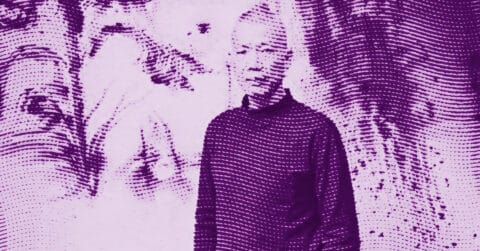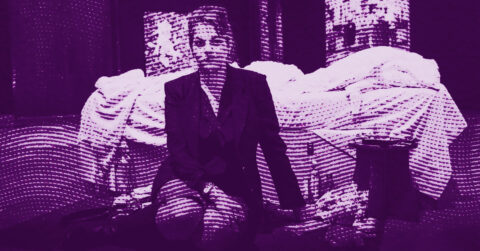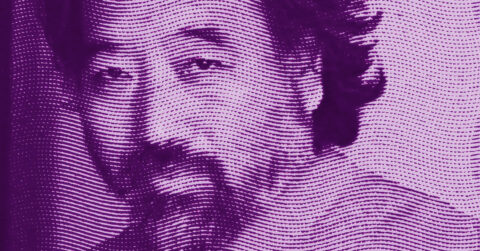Listen to me carefully, you bunch of snobs, I have a painter to introduce to you who will shake you out of your aesthetic torpor. Marina Perez Simão is not simply a Brazilian artist; she is a cosmic navigator guiding us through the uncertain borders of perception. In her paintings, this extraordinary woman captures the very essence of the moment when day embraces night, where dream blends with reality.
When I observe her works, I find myself like Ulysses facing the sirens of abstraction, seduced by these multiple horizons that overlap in a dizzying chromatic ballet. Simão’s compositions are not mere landscape evocations but mental maps where each colored layer corresponds to a state of consciousness. Ambiguity reigns supreme in her pictorial universe, and it is precisely this indeterminacy that constitutes her strength.
Merleau-Ponty’s phenomenology teaches us that perception is never a passive act, but an active construction where body and mind intertwine to give meaning to the world. “The visible and the invisible” constantly touch in the sensory experience, and this is exactly what Simão gives us to see in her compositions. Her impossible landscapes are battlefields where our perceptual certainties dissolve like morning mist over the hills of Minas Gerais. “The eye is not only sensitive to what is visible but to what makes it visible,” wrote Merleau-Ponty [1], and Marina Perez Simão’s paintings perfectly embody this dialectic in which the viewer actively participates in the emergence of meaning.
Let us take the example of her exhibition “Zwielicht” at the G2 Kunsthalle in Leipzig in 2024. These immense paintings, with their fluid movements and incandescent colors, do not represent so much places as transitions between different states of consciousness. The artist plunges us into a twilight in-between, an interval where the contours of the real dissolve to give way to inner visions. It is not without reason that “Zwielicht” means “twilight” in German, that fleeting moment when the light changes and transforms our perception of the world.
If phenomenology offers us a framework to understand Simão’s work, Fernando Pessoa’s poetry allows us to grasp its existential dimension. The Portuguese poet’s heteronymy, this ability to fragment himself into multiple creative personalities, finds a striking echo in the hybrid landscapes of the Brazilian artist. Just as Pessoa wrote under different heteronyms to explore various facets of the human experience, Simão multiplies viewpoints and horizons in her compositions.
In his poem “Autopsychography,” Pessoa states that “the poet is a faker” who “fakes so completely that he ends up faking the pain he really feels” [2]. This mise en abyme of subjective experience deeply resonates with Simão’s approach, which invites us to navigate between different layers of reality. Her paintings are visual simulations that, paradoxically, reconnect us to authentic sensations, the dazzlement before a setting sun, the vertigo facing the immensity of a landscape, the melancholy of a twilight.
During her “Onda” exhibition at the Pace Gallery in London in 2022, Marina Perez Simão presented a series of polyptychs where organic shapes seemed to continue from one panel to another, thus creating a fragmented yet coherent visual narrative. This shattered narrative structure is reminiscent of Pessoa’s “The Book of Disquiet,” that river-like work composed of fragments which, together, portray a consciousness in perpetual motion. “I am a fragment of a self whose wholeness I do not know,” Bernardo Soares, Pessoa’s heteronym, might have written while contemplating these paintings where unity is born from fragmentation.
Marina Perez Simão’s strength lies in her ability to transform the experience of the landscape into an inner exploration. The sensual undulations of her compositions are not mere representations of hills or waves but visual metaphors for our fluctuating states of mind. As she confided in an interview: “I break the composition to create a change of state, a promise of something beyond the painting.” This promise of a beyond, of surpassing the limits of the visible, is at the heart of her artistic approach.
The artist never works when she is sad, and that is a confession worth dwelling on! Contrary to the romantic myth of the tortured genius, Simão claims joy as a necessary condition for creation. “I have to feel good to be in the studio,” she says. This ethic of creative happiness translates in her canvases as a particular luminosity, a chromatic vibration that pulls us away from our daily gloom. Her abstract landscapes are machines for producing visual joy, optical devices that stimulate our neurons thirsty for beauty.
Simão’s training at the École des Beaux-Arts in Paris certainly influenced her painting technique, but it is in dialogue with the Brazilian landscape that she forged her unique visual language. The vibrant colors of her paintings, those incandescent oranges, deep blues, twilight purples, evoke the striking contrasts of Brazilian nature. “Everything is too much,” she says about her homeland, where storms suddenly arise and light radically transforms the landscape depending on the time of day.
What strikes in Marina Perez Simão’s work is this constant tension between control and surrender. Each painting is meticulously prepared through a series of watercolors and sketches, yet the artist always preserves a share of improvisation in the final execution. “I don’t like too much hesitation in painting,” she asserts, “I like the direct gesture.” This gestural fluidity gives her compositions an almost musical quality, as if each color were a note in a visual symphony.
To those who would reduce her work to a mere variation on landscape abstraction, I respond: open your eyes wide! Simão’s art transcends easy categories and invites us to a total sensory experience. Her paintings are not windows onto the world, but mirrors of our interiority, portals to parallel dimensions where the laws of physics are suspended.
Critic Hettie Judah rightly observed that in Simão’s polyptychs, “something interesting happens in the space between the panels.” These interstices, those few centimeters of white wall punctuating her works, become projection spaces for our imagination. What happens in these breaks? A lapse of time? A movement in space? These questions without definitive answers are an integral part of the aesthetic experience the artist offers.
Simão’s approach is part of a lineage of artists who have explored the boundaries between abstraction and figuration, from Georgia O’Keeffe to Helen Frankenthaler and Tarsila do Amaral. But she brings to this tradition a contemporary sensitivity, imbued with the ecological urgencies of our time. Her chimerical landscapes can be read as post-apocalyptic visions, alternate worlds where nature has reclaimed its rights after the anthropogenic catastrophe.
Do not think that Marina Perez Simão is a naive artist who is content to produce pretty images. Her work is deeply rooted in a reflection on the possibilities and limits of painting in the digital age. In a world saturated with virtual images, her canvases assert the irreducible presence of pictorial matter, the importance of gesture and body in the creative act.
When she talks about her creative process, Simão evokes this sensation of “ignorance” that she seeks: “I must surprise myself. I must have this feeling of ignorance: What is it? Where is it?” This posture of philosophical wonder, this constant questioning in the face of the visible, is at the heart of her approach. The painter does not offer us answers, but spaces of active contemplation where our certainties dissolve.
What can be said about her technique? Layers of paint accumulate on the canvas like geological strata, creating a depth that invites the eye to dive into the surface. The contrasts of matter, between smooth areas and impastos, between transparency and opacity, add a tactile dimension to the visual experience. One wants to caress these paintings as one would touch a dreamed landscape.
There is something deeply liberating in Marina Perez Simão’s art. By blurring the boundaries between inside and outside, between real and imaginary, she reminds us that our perception of the world is always a subjective construction, a creative process in itself. Her paintings are invitations to explore our own inner landscapes, to lose ourselves in the meanders of our consciousness.
The next time you find yourself in front of a Simão canvas, take the time to fully abandon yourself to it. Let your eyes wander among the colored strata, get lost in the sensual undulations of her compositions, breathe in rhythm with her chromatic contrasts. Art is not made to be understood, but to be lived, and few contemporary artists offer us an experience as intense as Marina Perez Simão.
Do not be those frivolous spectators who pass by paintings seeking immediate satisfaction. Be rather those fearless travelers ready to embark on a journey into the unknown. Because this is what Simão’s work is about: an invitation to travel, not to distant lands, but to the unexplored territories of our own sensitivity.
And if you are not capable of such openness, if you prefer to cling to your aesthetic certainties, then too bad for you! You will miss out on one of the most exhilarating visual experiences that contemporary art has to offer. Marina Perez Simão does not need your approval; her canvases will continue to shine long after your hasty judgments have been forgotten.
- Merleau-Ponty, Maurice. “The Visible and the Invisible,” Gallimard Editions, Paris, 1964.
- Pessoa, Fernando. “Autopsychography” in “Poems of Fernando Pessoa,” Christian Bourgois Publisher, Paris, 2001.
















